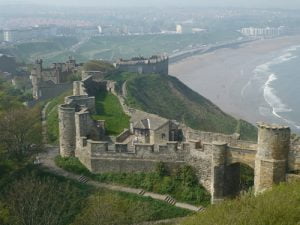
Scarborough!
Scarborough is a seaside resort and fishing port on the northeast coast of England. The town is said to have been founded around 966 AD as Skarðaborg by Thorgils Skarthi, a Viking chieftain, though there is no archaeological evidence to support the claim. Historically, part of North Yorkshire, the town is generally recognised as Britain’s first seaside resort and has been welcoming visitors for more than 350 years. The older part of the town lies around the harbour, which is protected by a rocky headland that rises up to 70 m in height.
Scarborough’s long and turbulent means it has a legacy of connections with the supernatural world. So, if you enjoy a good ghost story, here are three spooky tales from the Scarborough area.
The Infamous Ghost of Scarborough Castle

Image credit: John R Martin/Shutterstock.com
A Royal Scandal
Scarborough Castle is a medieval royal fortress, situated on a rocky headland. It overlooks both the North Sea and the town of Scarborough. The castle was constructed during the of reign of King Stephen, being completed about 1150. One of the most scandalous incidents of the castle’s history involves Piers Gaveston, a 14th century Earl of Cornwall. The event has given rise to the legend of arguably Scarborough’s most infamous ghost.
Gaveston was a particular favourite, and the rumoured lover, of Edward II. However, he did not find favour with the barons of England. They constantly complained of the undue influence of Gaveston on the king. In 1311, Gaveston was forced into exile following the recommendations of a royal commission. However, he returned to Edward’s royal fold only a year later. The reinstatement of Gaveston infuriated some of England’s most powerful noblemen. These included the Earl of Lancaster, the Earl of Pembroke, the Earl of Warren and Henry de Percy, the former keeper of Scarborough Castle. The barons decided it was high time to sort things out once and for all.
Gaveston’s Revenge
Gaveston was in York when he got word that the barons were on his trail. He fled to Newcastle, then took a ship to Scarborough. King Edward quickly installed him as governor of the castle, for his protection. However, the combined armies of Pembroke, Warren and de Percy, soon overpowered Gaveston’s meagre defence forces and he was taken prisoner. On 19 June 1312, the Earl of Lancaster ordered Gaveston’s execution. He was taken to Blacklow Hill, about a mile from Warwick, where he was beheaded. The furious king could not forgive Scarborough. He ordered that the town be placed under the control of the most authoritarian governors he could muster.
Today, Gaveston’s headless ghost is said to haunt the ruin of Scarborough Castle. The evil spectre is said to behave in a malicious manner, lunging at unsuspecting visitors. He hopes to lure them over the castle walls, falling to certain death on the rocks below. Many people have claimed to have experienced a feeling of being pushed towards the castle walls, whilst hearing the manic laugh of a man.
The Tragic Story of the Pink Lady

Image credit: Ironika/Shutterstock.com
A Murder Mystery
The Georgian ‘Old Mansion’ House in St Nicholas Street, Scarborough has a tragic tale to tell. In 1804, teenager Lydia Bell was living at the house with her family. Over some months, Lydia had built somewhat of a friendly relationship with a young army officer who was stationed at the town’s Castle Hill barracks. Her father strongly disapproved of the liaison, so on an evening where he and Mrs Bell were to enjoy a night out, he thought it prudent to lock Lydia in her room. However, strong-willed Lydia was determined to meet up with her handsome soldier boyfriend. Thus, she managed to escape from the room with the help of a do-good neighbour.
Clad in a distinctive pink frock, Lydia headed out on her date. Tragically, she was found strangled to death on Scarborough beach the following morning. Initially, the army officer was charged with her murder but was eventually acquitted due to lack of any evidence. Many years later, a man unbeknown to the police confessed to Lydia’s murder on his deathbed.
The Ghostly Girl in Pink
Ever since Lydia’s sad death, the distressed ghost of the teenager has reportedly been sighted many times. Usually, she is seen hanging around Old Mansion House or close by in St Nicholas Street. A couple who lived in the house during the 1940s stated that their young daughter had once cried because ‘the lady in the pink frock would not let her into the garden’. However, when they searched for such a person, she was nowhere to be found.
Shortly after the Second World War ended, the old house was converted to flats. Some of the new residents reported that they either saw or felt the presence of Lydia’s ghost. Later, the house was included in a streetscape, that was painted by an artist who was totally unaware of its history. However, for an inexplicable reason, he included a pretty girl in a pink dress ascending the steps of the former Old Mansion House in his painting.
The Tall Tale of Bert Marshall

Image credit: kviktor/Shutterstock.com
Penny-pinching Bert
Folklore has it that a number of years ago there was a skinflint farmer named Bert Marshall who lived in the village of Robin Hood’s Bay. The picturesque fishing village lies between Scarborough and Whitby. Whilst, Yorkshire folk are generally renowned for their frugality, Bert reportedly took the art of miserliness to a whole new level. When his false teeth had come to see better days, tight-fisted Bert decided he didn’t want to pay to replace them. Instead, he stooped to stealing a set of dentures from a corpse in order to replace his worn-out gnashers.
By this time, Bert had taken to walking everywhere, since his old horse could no longer make it very far from the farm. The Whitby to Scarborough railway line provided the most direct route to most of the places Bert wanted to go. Thus, he took to walking the line on a regular basis. There was one thing that Bert didn’t mind splashing out on – and that was alcohol. Every Friday night, Bert would walk the five miles along the railway line to his favourite watering hole, the Windmill Inn at Stainsacre.
An Untimely Death
The story goes that on one particular dark and stormy night, the intoxicate Bert set off on his way back home from the Windmill. There were obviously no witnesses but it was supposed that the hapless Bert had dropped his teeth on the railway line. and had bent over to pick them up. With more than a few drinks on board, Bert had toppled over, knocked himself unconscious, and ended up prostrate across the track. Bert’s fate was decapitation by curtsey of the next on-coming train. When police arrived at the horrific scene they found his headless corpse still on the rail tracks. It was assumed that Bert’s head must have been taken by wildlife.
In the following months, Bert’s family searched tirelessly for his head but it was never found. At the time of Bert’s funeral, it was very much thought that the spirit of a corpse, buried without an head, would never be able to rest in peace. Thus, it’s claimed on moonless nights, on that stretch of the train track where Bert met his fate, his wandering headless ghost can often be seen. Apparently, Bert still carries with him his notorious false teeth, clacking them together in a noisy fashion. He hopes that the clatter will somehow help him to end his relentless quest in the search for his missing head.
Header image credit: Jack Cousin/Shutterstock.com